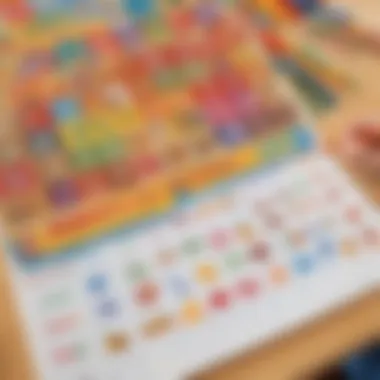Understanding Kindergarten Days of the Week


Intro
The foundation of a child's understanding of the world begins with the simplest concepts, and one of those is the days of the week. For young learners, grasping the sequence and significance of these days is more than just memorizing names; it plays a crucial role in developing their sense of time and organization. This understanding affects their routines, social interactions, and cognitive growth.
Teaching days of the week in kindergarten involves more than just rote learning. It requires engaging methods that capture children's attention and encourage them to explore the concept of time. Let's delve into some effective approaches to make learning about the days of the week enjoyable and meaningful.
Interactive Learning Games
Gamification is a powerful tool in education. Using games makes the learning process not only effective but also enjoyable for kindergarteners.
Popular Games
Some educational games focus directly on teaching days of the week. These games can enhance children's memory, recognition, and engagement.
- Days of the Week Song: A catchy tune that helps kids remember the order of days.
- Calendar Puzzle: A hands-on activity where children can physically place days on a calendar.
- Matching Game: Pairing days with activities scheduled on those days can reinforce learning.
Description of top educational games
Each game can serve different learning styles. For example, the Days of the Week Songuses auditory learning to help those who retain information better through music.
Calendar Puzzle addresses kinesthetic learners, allowing them to engage physically while learning.
Benefits of playing educational games for kids' cognitive development
Playing educational games supports various aspects of cognitive development. They help improve memory, enhance problem-solving skills, and facilitate social interaction among peers.
Game Reviews
In this section, we critically analyze selected games for effectiveness.
- Days of the Week Song: Feedback shows that it is widely loved and easier to remember by students.
- Calendar Puzzle: Teachers report that this hands-on approach significantly boosts understanding of how weeks are structured.
Comparison of gameplay and learning outcomes
When comparing these games, the Days of the Week Song excels in recall, while the Calendar Puzzle shines in application. Both are beneficial, but pairing them can cover a broader spectrum of learning needs.
Creative DIY Projects
Hands-on activities also contribute to learning the days of the week. DIY projects allow children to express creativity while reinforcing their understanding.
Step-by-Step Guides
One engaging project is creating a days of the week wheel. Here's how to make it:
- Materials: A paper plate, markers, and a brad fastener.
- Create the Wheel: Divide the plate into seven sections and label each with a day.
- Customize: Encourage kids to draw pictures representing activities they do each day.
Craft Ideas
Using simple household items can lead to imaginative craft ideas. For instance, making a calendar using colored paper and stickers can be an engaging way to teach the days.
- Importance of artistic expression in children's development: Engaging in arts and crafts helps children develop fine motor skills, creativity, and emotional expression.
"Learning is more effective when it connects with children's interests and creativity."
Furthermore, these strategies not only educate but also foster a love for learning, laying the groundwork for more complex concepts in the future.
Prologue to Days of the Week
Understanding the concept of days in a week is fundamental in kindergarten education. Kids at this stage are beginning to make sense of time, sequence, and structure. Introducing the days of the week not only helps children grasp how time is organized, but it also lays a foundation for building routines in their daily lives. This knowledge can affect their social interactions and help them become more aware of their environment.
The Concept of Time in Early Childhood
In early childhood, children perceive time differently than adults. They often see it as a series of events rather than a linear progression. Teaching them the days of the week allows educators to introduce a structured timeline, helping them understand the flow of a week. Children can begin to associate specific activities with certain days, such as school days, playdates, or family outings.
It is essential for educators to engage children with practical examples. For instance, linking the days with familiar events can create a clearer understanding of time. Showing a calendar can also be effective. Children learn best when they see how time directly relates to their lives.
Importance of Learning the Days
Learning about days of the week can result in several key benefits for kindergarten students.
- Routine Establishment: Understanding days enhances kids' ability to anticipate events, which is crucial for establishing daily routines.
- Social Skills Development: As children learn to communicate their schedules, they become better at expressing their needs and plans, enhancing social interactions.
- Sequence Recognition: Engaging with days of the week helps children develop their sequence skills. This is important for many academic subjects, including math and reading.


Parents and educators need to recognize these benefits. Therefore, creating learning experiences around the days of the week can lead to significant cognitive advancements for young minds.
"Establishing an understanding of days can serve as a stepping stone for children's future learning and development."
Educational Framework for Teaching Days
An educational framework for teaching days of the week is crucial in structuring how information is delivered to young learners. This framework offers a systematic approach tailored to their cognitive and emotional development. It ensures that instruction is both engaging and effective, laying a solid foundation for understanding time concepts. When educators design their lessons around this framework, they enable children to assimilate knowledge more rapidly and meaningfully.
Cognitive Development Stages
Understanding cognitive development stages is essential for crafting lessons that resonate with kindergarten students. Jean Piaget’s theory provides insights into how children think and learn in various stages. For instance, preschoolers often operate within the preoperational stage, where they learn through play and visual aids. In this context, teaching the days of the week can involve using colorful charts or flashcards that represent each day. These tools cater to their ability to engage with material visually and tangibly.
Moreover, these cognitive stages highlight the importance of using relatable examples. When a teacher relates each day to lively events, such as a class gathering or an art project, it fosters better retention. As the children explore these events in relation to the days of the week, they grasp time concepts more comprehensively. This approach not only builds their knowledge base but also nurtures their ability to connect different experiences to specific days.
Curriculum Alignment
Curriculum alignment is another critical aspect of teaching the days of the week effectively. The curriculum must incorporate the concept of time as an essential element of a child’s learning experience. Integrating days of the week into other lessons—such as math or storytelling—can reinforce this understanding. For example, teachers might incorporate counting activities where children learn how many days are in a week or create stories based on events happening throughout the week.
Furthermore, aligning lessons with state educational standards ensures that the teaching methods used are relevant and purposeful. Educators should consider incorporating standard resources that focus on days of the week, helping them to frame their lessons around the goals set by curriculum guidelines. This alignment not only supports children’s learning but also helps educators track progress over time.
In summary, both cognitive development stages and curriculum alignment play a pivotal role in teaching days of the week in kindergarten. By focusing on these elements, educators can create an enriching environment that promotes deeper understanding while also fulfilling educational objectives.
"Teaching young children about days of the week is not just about naming them, it’s about instilling a sense of time that will guide their routines and learning for years to come."
By prioritizing these frameworks, teachers can ensure that the teaching of days becomes an engaging and meaningful part of a child’s educational journey.
Practical Strategies for Instruction
Teaching the days of the week forms a critical base in early education. Practical strategies enhance children's grasp of time, promoting more effective learning experiences. These approaches not only make the topic engaging but also cater to different learning styles. It is essential to consider children’s varied developmental stages when selecting these strategies.
Utilizing Visual Aids
Visual aids serve as vital tools for instruction in early learning environments. Images, charts, and illustrations connect abstract concepts to something tangible. For instance, a colorful wall chart displaying each day of the week helps children visualize the flow of time. This technique can reinforce the sequential nature of the week while capturing their attention.
Visuals can also support memory retention. Studies indicate that children often remember visuals better than text. A simple picture associated with each day can trigger recall and understanding. Use icons to represent activities on specific days, like a book for Monday, a bicycle for Friday, or a family for Sunday. Such representations can make the days of the week more relatable and understandable.
Additionally, integrating technology, such as educational apps, can enhance this visual approach. Programs often include interactive elements that appeal to a young audience. This combination of visual and interactive learning tends to improve focus and engagement.
Incorporating Daily Routines
Daily routines are a natural method to reinforce concepts of the days of the week. Consistency is key here. When children can participate in structured activities connected to each day, they start to connect the dots in their understanding. For example, if every Tuesday is "Tidy-Up Tuesday," children can physically engage with the concept while also remembering the day associated with the activity.
Using calendars within the classroom routine can also help. Encourage children to mark the current day and discuss upcoming plans. By making it part of daily discussions, they learn the relevance of the days in relation to their own lives. Teachers can involve children by asking them questions about what they will do later in the week. This kind of participation strengthens their grasp on routines while embedding the chronological sequence of the week in their memory.
Interactive Learning Activities
Interactive learning activities offer engaging ways to teach the days of the week. Role-playing games, where children act out various activities corresponding to each day, can be particularly effective. For instance, a mock grocery store visited on "Shopping Saturday" allows them to practice vocabulary and sequencing skills.
Another effective method is through songs and chants. Numerous educational songs introduce days of the week in a fun, memorable way. Movement can be included, such as dancing to a catchy tune while learning. This combination of physical activity and learning leads to deeper retention.
Utilizing storytelling can also capture children’s imaginations. Create narratives that involve characters experiencing different days. This contextualizes the learning and makes it vivid. Reading a story where the protagonist faces challenges throughout each day can link them to their meanings practically.
In summary, employing visual aids, establishing daily routines, and creating interactive activities fosters a more effective learning environment for understanding the days of the week. These approaches not only make learning enjoyable but also accommodate various developmental needs of young learners.
Role of Technology
In today's education, technology plays a pivotal role in how children learn and understand concepts like the days of the week. This area is particularly significant for kindergarteners, as they are just beginning to grasp the fundamental elements of time and scheduling. Integrating technology into the learning process enhances engagement and facilitates interactive experiences, allowing children to connect abstract ideas to tangible outcomes.
Digital Resources and Apps
Several digital resources and apps assist in teaching the days of the week. These tools often feature colorful graphics and engaging sounds, capturing the attention of young learners. For instance, applications like Starfall and ABCmouse offer interactive games that reinforce the concept of daily routines. Children can participate in activities that involve identifying days, sequencing events, and even recognizing days related to various themes or celebrations.
Parents and educators should consider the following benefits when using digital resources:
- Interactive Engagement: Children are more likely to retain information when learning through play.
- Adaptability: Many apps are adjustable, catering to the varying learning speeds of children.
- Accessibility: With a device, learning can happen anywhere, making it easy for families to practice at home or even during travel.
These resources do not just provide entertainment; they lay the groundwork for fundamental time concepts.
Online Learning Modules
Online learning modules offer structured curriculums that enhance traditional teaching methods. Using platforms like Khan Academy Kids and Scholastic, educators can implement lesson plans focused on the days of the week into their classrooms.


Key features of these modules include:
- Comprehensive Lessons: They provide in-depth coverage of concepts in time, making the material suitable for various age groups.
- Assessment Tools: They often come with built-in quizzes and assessments, allowing teachers to gauge a child's understanding effectively.
- Flexibility: These modules can be used in synchronous or asynchronous learning settings, adapting to classroom needs.
An important factor for successful integration is ensuring that the technology aligns with curriculum goals. The objective is to enhance learning, not overwhelm children with too much information.
"Effective use of technology can transform the learning experience, making it more engaging and impactful for young students."
By thoughtfully incorporating digital resources and online modules, teachers, and parents can support kindergartners in developing a solid understanding of the days of the week.
Assessing Understanding
Assessing understanding is a critical aspect in teaching kindergarten. When children learn about the days of the week, it is essential to evaluate how well they grasp the concept. This assessment informs educators about each child's progress and helps them tailor their instruction accordingly. Methods of understanding can reveal children's cognitive abilities and their mastery over this foundational topic. Regular assessments not only encourage children but also provide invaluable feedback to parents and educators.
Methods of Evaluation
To effectively assess understanding, educators can use several methods. Each method serves a distinct purpose and provides various insights.
- Quizzes and Tests: Short quizzes can gauge knowledge retention. Simple questions about the sequence of the days may suffice for this age group.
- Oral Assessments: Engaging children in conversation allows teachers to hear their responses and clarify their thinking.
- Hands-on Activities: Practical activities can also reveal understanding. For example, asking students to arrange cards labeled with days of the week in order helps demonstrate comprehension through action.
Additional methods may involve the use of visuals. Children often respond well to picture-based assessments, where they match images representing activities to the correct day of the week.
Observational Techniques
Observational techniques are another powerful tool for assessing understanding. These methods provide insights that more structured forms of evaluation cannot capture. Here are key points to consider:
- Natural Settings: Observing children during normal classroom activities allows educators to see their application of the days of the week. When children say, "Today is Wednesday, and we have art class," it shows they connect specific days to their routine.
- Peer Interactions: Watching how children interact with each other when discussing days can reveal their understanding. If they correct each other or use the terms correctly, it indicates mastery.
- Engagement Levels: Monitoring how engaged students are during lessons is important. If a student consistently participates and shows enthusiasm about learning the days, it likely reflects a strong understanding.
By utilizing these techniques, teachers can form a comprehensive picture of each student's grasp of the days of the week.
"The best assessments often take place in everyday contexts, where children naturally express their understanding."
Involving Parents in Education
Involving parents in the education process, especially in teaching the days of the week, is vital for early childhood development. Parents play a significant role in reinforcing concepts learned in the classroom. Their involvement can enhance children's understanding and retention of information regarding time and scheduling. When parents actively participate, they not only support their children’s learning but also foster a positive attitude towards education.
Effective communication between parents and educators can bridge gaps in understanding. It promotes consistency in learning both at school and at home, further assisting children in assimilating new information. This collaboration allows parents to share insights about their child’s progress, enabling teachers to tailor their approach more effectively. Without this interaction, children may receive mixed messages about the importance of learning.
Communication Strategies
Establishing strong communication strategies can significantly enhance parental involvement. Regular updates about classroom activities and learning objectives can inform parents about what their children are learning. This can be done through newsletters, emails, or even a dedicated platform where parents can access information easily. Parents should be encouraged to ask questions and provide feedback about the materials their children are engaging with at home.
Here are some effective communication strategies:
- Regular Parent-Teacher Meetings: Schedule meetings to discuss children's progress and ways to support learning at home.
- Interactive Workshops: Organize workshops that educate parents on teaching techniques that they can apply at home.
- Resource Sharing: Provide parents with resource lists, such as websites or apps related to teaching days of the week.
"The more informed parents are, the more they can contribute to their child's educational journey."
By employing these strategies, parents can stay involved and informed, which benefits children's educational experience.
At-Home Learning Activities
At-home learning activities provide parents with tools to reinforce what children learn at school. Simple daily routines enable mothers and fathers to integrate the days of the week into ordinary life, making learning feel natural and relevant. This reinforcement can lead to deeper understanding and familiarity.
Engaging children in activities can involve:
- Creating a Weekly Calendar: Teach children to recognize the days by having them help create a calendar. They can mark important family events or milestones.
- Daily Conversations About the Week: Incorporate discussions about the day’s activities. Ask questions like, "What did we do on Monday? What do we have planned for Wednesday?"
- Games and Songs: Utilize songs that incorporate days of the week. Games like matching days to activities can also enhance recognition in a fun way.
These activities not only reinforce learning but also create bonding moments between parents and children. They can foster an environment where children feel comfortable to explore concepts and ask questions surrounding the days of the week.
In summary, parental involvement is critical in early education. Effective communication strategies and engaging at-home activities can make a notable difference in how children perceive and understand the concept of time and scheduling.
Challenges in Teaching Days of the Week
Teaching the days of the week to young children entails navigating a range of challenges. Understanding these obstacles is essential for educators, parents, and caregivers alike. Recognizing these issues allows for more effective strategies and support systems to be put in place. This section explores the development-related differences among children and their diverse learning styles, highlighting how each factor influences the teaching process.
Developmental Differences Among Children
Children exhibit various developmental stages that affect their ability to grasp the concept of the days of the week. For instance, a five-year-old may have different cognitive abilities compared to a six-year-old. Some children recognize patterns and sequences easily while others struggle with the abstract notions of time.
- Cognitive maturity: Younger children may find it hard to understand a week as a whole and instead think of days in isolation.
- Language comprehension: The vocabulary associated with days can be complex for some, depending on their language development.
- Attention span: Children's attention spans vary significantly; thus, some may need more engaging and interactive methods to retain information.


It is crucial to tailor teaching methods to match these developmental stages. Not every child absorbs information at the same pace. With varying degrees of readiness, educators must create an inclusive environment that meets the needs of every learner.
Diverse Learning Styles
Teaching approaches should accommodate the unique learning styles present in a kindergarten classroom. Children learn in multiple ways, and recognizing these styles is key in effectively teaching the days of the week. Some common learning styles include:
- Visual learners: Such children benefit from charts and colorful graphics.
- Auditory learners: Songs and repeated verbal instructions engage this type of learner effectively.
- Kinesthetic learners: These children need hands-on activities to grasp concepts, such as using physical objects to represent each day.
By integrating various teaching methods, educators can help all children understand and remember the days of the week. Using a combination of visual aids, songs, and activities can cater to these diverse learning styles and create a supportive educational environment.
Key takeaway: Acknowledging developmental differences and diverse learning styles fosters a more effective educational experience, allowing all children to thrive as they learn about the days of the week.
Cultural Context of the Days of the Week
Understanding the cultural context of the days of the week is essential for educators teaching kindergarten students. This theme plays a significant role in how children experience time based on their societal and familial backgrounds. Recognizing that the concept of days varies across different cultures fosters a deeper appreciation for diversity. Moreover, when educators acknowledge these differences, they help children make connections between their learning materials and real-life experiences, enhancing both engagement and retention.
Understanding Variations Across Cultures
Around the world, the names and significance of each day carry distinct cultural meanings. For instance, in many Western cultures, the week begins on Sunday or Monday, emphasizing a fresh start and productivity. In contrast, some Middle Eastern cultures view Saturday as the last day of rest before the work week begins. Additionally, festivals, holidays, and religious observances often dictate how days are perceived in a given culture.
- Days as Symbols: In various cultures, particular days may symbolize rest or reflection. For example, Sunday is regarded as a day of worship in Christianity, while Friday holds special importance in Islam.
- Different Calendars: Cultures may also adopt specific calendars, leading to different interpretations of the week. The Gregorian calendar is prevalent in the West, but the Hebrew and Islamic calendars follow different structures.
Educators can utilize this information to create lesson plans that resonate with children from diverse backgrounds. This approach not only enriches the children's understanding but also instills a sense of pride in their cultural identity.
Incorporating Cultural Sensitivity in Teaching
Incorporating cultural sensitivity into teaching about the days of the week requires thoughtful strategies. Educators must ensure that every child's background is respected and affirmed within the classroom.
- Diverse Materials: Select books and resources that showcase various cultural traditions associated with the days of the week. For example, stories that portray different weekend activities from around the globe can engage young learners, providing relatable content.
- Celebrating Diversity: Create activities that encourage children to share what their weekends or significant days entail. Such activities promote discussion of customs, helping foster a culturally inclusive classroom environment.
- Community Engagement: Involve parents in discussions about how their families celebrate specific days. Input from families can guide educators on how to structure activities that respect different values and beliefs.
A culturally aware lesson on days of the week builds empathy and appreciation, showing children the beauty of differences while strengthening community ties.
Evaluation of Educational Resources
When discussing the learning of the days of the week in kindergarten, a thorough evaluation of educational resources is essential. Resource evaluation involves analyzing available materials and tools to determine their effectiveness in teaching concepts of time and routine. Kindergarten educators must understand that different resources can cater to varying learning styles and developmental stages. The right tools can enhance engagement and retention of knowledge, assisting young learners in grasping this crucial foundational concept.
Educational resources can range from books, interactive apps, visual aids, to hands-on materials. Each resource's benefits and considerations should be evaluated critically. It is vital to consider the alignment of these resources with early childhood education standards. This ensures that the teaching methods support developmental goals, rather than distract from them.
"Effective evaluation of educational resources leads to better learning outcomes for students, shaping their understanding of time intricately."
Comparative Analysis of Tools and Materials
In conducting a comparative analysis, various tools and materials used for teaching the days of the week should be examined. Traditional methods, such as calendar displays, are often contrasted with modern digital tools like educational apps. Each method has its strengths and weaknesses. For example:
- Traditional Visual Aids: These can include wall charts, flashcards, and storybooks. They foster tangible interaction and can be customized to fit classroom themes.
- Digital Learning Tools: Applications like Endless Alphabet or Starfall offer interactive experiences. They can engage students with animations and sounds but might lack the physical interaction some children require.
- Hands-on Learning Materials: Tools like counting blocks or day-specific toys can provide a tactile experience. They help children to connect abstract concepts with concrete examples.
By analyzing these tools in terms of accessibility, engagement, and educational value, educators can choose the most suitable materials that fit their teaching style and the needs of their students.
Effectiveness of Different Teaching Aids
To determine the effectiveness of teaching aids for the days of the week, it is pertinent to assess how well they support learning outcomes. Critical considerations include clarity, child engagement, and adaptability. Some teaching aids can engage children simply through their design. For instance:
- Colorful Charts: Brightly colored charts representing days can attract attention and make learning more appealing for young children.
- Storybooks: Implementing stories that revolve around daily routines can help contextualize the days in a way that children can relate to.
- Games and Activities: These can serve as effective tools. When children learn through play, they often retain information better due to enjoyment and engagement.
To effectively choose teaching aids, educators should test these resources in real classroom settings. Observational assessment can reveal which aids resonate more with students.
Concluding Thoughts
The concluding section of this article emphasizes why understanding the days of the week is essential in kindergarten. It condenses the core points discussed earlier and highlights the multifaceted nature of the topic. By recognizing the importance of time concepts, young learners can develop a sense of organization, responsibility, and routine. Teaching days of the week provides a framework for their daily lives, enabling them to better manage time and anticipate future events.
Key Benefits of Teaching Days of the Week:
- Cognitive Growth: Understanding temporal concepts is crucial for a child’s cognitive development. It helps them grasp the structure of their week and link past, present, and future events.
- Routine Establishment: Children thrive on routine. Learning about days of the week instills a sense of order, making it easier for them to engage in daily activities.
- Social Skills Development: Knowing how to reference time promotes interactions with peers and adults. It encourages discussions about planned events and shared experiences.
- Cultural Awareness: Teaching about the days of the week also opens a window to discussions about cultural perspectives on time and routine.
In summary, this concluding section provides a snapshot of the importance of teaching the days of the week within a kindergarten framework.
Summarizing Key Takeaways
- Integration of Learning: This article highlights that learning about the days of the week cannot stand alone. It must be integrated into broader educational contexts where children can connect their knowledge of time to daily routines and experiences.
- Diverse Methods: Various teaching strategies can be adopted, utilizing visual aids, digital resources, and interactive activities to cater to different learning styles among children.
- Involvement of Stakeholders: Collaboration among parents, teachers, and caregivers plays a pivotal role since reinforcing these concepts at home is equally important.
Looking Ahead: Future Implications
Looking forward, the future implications of teaching the days of the week in kindergarten extend beyond early childhood education. As society evolves, the ways in which children conceptualize time may also change. Educators should stay informed about technological advancements that can augment learning experiences.
This might include incorporating augmented reality applications or interactive software that can visually represent the days in an engaging play environment. Additionally, cross-cultural teaching approaches will help children appreciate and understand different interpretations of time. As young learners become more globally aware, teaching days of the week can easily adapt to reflect those changes.
Overall, preparing children for a world where they can skillfully navigate time-related concepts will not only benefit their educational journeys but also empower them in their daily lives.















